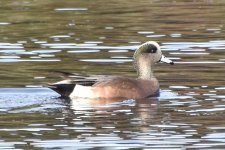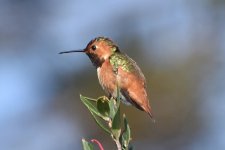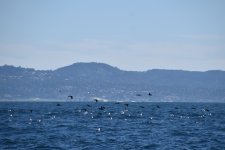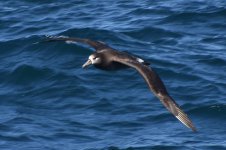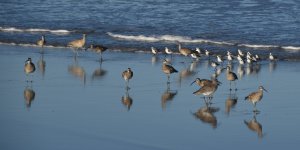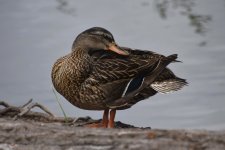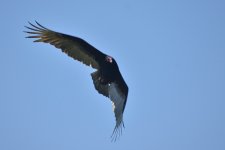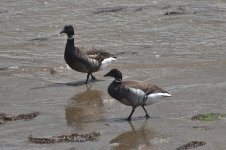8 March 2024
Wanting a better look at the Mountain Plovers, this morning I began back at Road 45. The sun was at my back and the birds were there, but they stayed far out in the field. There were looks, but no close views or decent photos. The short eBird list is here: https://ebird.org/checklist/S164335456. On I went.
The next stop was Colusa National Wildlife Refuge. This is one of several similar refuges in the Central Valley of California, managed mainly for waterfowl. I did not expect to see anything there that I had not already seen, or could not see easily elsewhere, but having once seen a Falcated Duck at the refuge I had fond memories of the place. Maybe there was a Falcated Duck wintering there now - maybe a Garganey or a Smew. We will never know – except for a small area around the entrance it was closed due to flooding. I should have checked the website. I birded around the open area and did find a good variety of birds, including a Bald Eagle. At this link one can find an eBird list for the visit: https://ebird.org/checklist/S164337118.
The next site I went to was a place I had not been to previously. It was in the hills on the west side of the Sacramento Valley along Putah Creek, which forms the boundary between Yolo and Solano Counties. A Winter Wren has been there. Years ago we had lots of Winter Wrens in California, but then they decided that the western American birds differed from the eastern American birds and that both differed from the Eurasian Wren. Now we have lots of Pacific Wrens and very few Winter Wrens, which name is now reserved for the eastern-breeding birds. And we have the problem of distinguishing the few Winter Wrens that may wander our way from Pacific Wrens. There are some subtle plumage differences, but mostly it is a matter of recognizing distinctive vocalizations. The latest report I saw on this bird, from the eBird hotspot Putah Creek – fishing access #1, put it at “the eastern end of FA2 near the little island”. It seemed like fishing access #2 would be the place to go. As I drove up the road along the creek I passed Fishing Access Site #5, then #4, then #3, and then #1. There was no FA2. I went up the rest of the road, as far as it followed the creek, and still found no Fishing Access Site #2. I went back to site #1 and walked down the creek toward site #3. It was quite birdy, including a surprising number and variety of waterfowl on the small creek. There was an Anna’s Hummingbird building a nest. (There is a photo of the hummingbird nest on the ebird list. For scale, the largest branches in the photo have a diameter of about 2 inches or 5 cm.) I passed two little islands. There were various woodpeckers and warblers, but the only wrens were a couple of Bewick’s Wrens. Well, I guess that solved the problem of trying to distinguish the Winter from Pacific Wrens. My eBird list: https://ebird.org/checklist/S164339094.
A long drive home. No new species today.
Wanting a better look at the Mountain Plovers, this morning I began back at Road 45. The sun was at my back and the birds were there, but they stayed far out in the field. There were looks, but no close views or decent photos. The short eBird list is here: https://ebird.org/checklist/S164335456. On I went.
The next stop was Colusa National Wildlife Refuge. This is one of several similar refuges in the Central Valley of California, managed mainly for waterfowl. I did not expect to see anything there that I had not already seen, or could not see easily elsewhere, but having once seen a Falcated Duck at the refuge I had fond memories of the place. Maybe there was a Falcated Duck wintering there now - maybe a Garganey or a Smew. We will never know – except for a small area around the entrance it was closed due to flooding. I should have checked the website. I birded around the open area and did find a good variety of birds, including a Bald Eagle. At this link one can find an eBird list for the visit: https://ebird.org/checklist/S164337118.
The next site I went to was a place I had not been to previously. It was in the hills on the west side of the Sacramento Valley along Putah Creek, which forms the boundary between Yolo and Solano Counties. A Winter Wren has been there. Years ago we had lots of Winter Wrens in California, but then they decided that the western American birds differed from the eastern American birds and that both differed from the Eurasian Wren. Now we have lots of Pacific Wrens and very few Winter Wrens, which name is now reserved for the eastern-breeding birds. And we have the problem of distinguishing the few Winter Wrens that may wander our way from Pacific Wrens. There are some subtle plumage differences, but mostly it is a matter of recognizing distinctive vocalizations. The latest report I saw on this bird, from the eBird hotspot Putah Creek – fishing access #1, put it at “the eastern end of FA2 near the little island”. It seemed like fishing access #2 would be the place to go. As I drove up the road along the creek I passed Fishing Access Site #5, then #4, then #3, and then #1. There was no FA2. I went up the rest of the road, as far as it followed the creek, and still found no Fishing Access Site #2. I went back to site #1 and walked down the creek toward site #3. It was quite birdy, including a surprising number and variety of waterfowl on the small creek. There was an Anna’s Hummingbird building a nest. (There is a photo of the hummingbird nest on the ebird list. For scale, the largest branches in the photo have a diameter of about 2 inches or 5 cm.) I passed two little islands. There were various woodpeckers and warblers, but the only wrens were a couple of Bewick’s Wrens. Well, I guess that solved the problem of trying to distinguish the Winter from Pacific Wrens. My eBird list: https://ebird.org/checklist/S164339094.
A long drive home. No new species today.
Attachments
Last edited:











